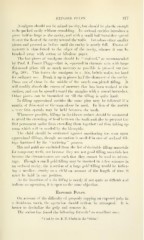Page 679 - My FlipBook
P. 679
EXPOSED PULPS. 677
Amalgam should not l)e mixed too drv, l)nt should be plastic enough
to be packed easily Avithout crumbling. In occlusal cavities introduce a
piece half as large as the cavity, and with a small ball l)urnisher spread
it over the floor of the cavity toward the walls. Introduce other smaller
pieces and proceed as before until the cavity is nearly full. Excess of
mercury is thus forced to the edges of the cavity, whence it can be
brushed away with cotton or bibulous paper.
The last pieces of amalgam should be " wafered," as recommended
by Prof. J. Foster Flagg—that is, squeezed in chamois skin with large
flat-nosed pliers till as much mercury as possible is pressed out (see
Fig. 288). This leaves the amalgam in a thin, brittle wafer, too hard
for ordinary use. Break it up in pieces half the diameter of the cavity.
Press one of these in the middle of the nearly completed tilling. It
will readily absorb the excess of mercury that has been worked to the
surface, and can be spread toward the margins with a round burnisher.
Other pieces can be burnished on till the filling is quite hard.
In filling a})proximal cavities the same plan may be followed if a
matrix of thin steel or German silver be used. In lieu of the matrix
a very thin spatula may be held between the teeth.
Whenever possible, fillings in deciduous molars should be contoured
to avoid the crowding of food between the teeth and also to prevent the
first permanent molar from crowding them together and thus taking up
room which will be needed by the bicuspids.
The child should be cautioned against masticating too soon upon
approximal fillings, though no caution is needed in case of occlusal fill-
ings hardened by the " wafering " process.
Tin and gold are excluded from the list of desirable filling materials
for temporary teeth, not because they are not good filling materials but
because the circumstances are such that they cannot l)e used to advan-
tage. Though a small gold filling may be inserted in a few minutes in
an occlusal cavity, the insertion of a large gold filling would be inflict-
ing a needless cruelty on a child on account of the length of time it
must be held in one position.
As the insertion of a tin filling is nearly if not quite as difficult and
tedious an operation, it is o])en to the same objection.
Exposed Pulps.
On account of the difficulty of properly capping an exposed pulj) in
a deciduous tooth, the operation should seldom be attempted. It is
better to devitalize the Jiulp and remove it.
The writer has found the following formula' an excellent one:
» Used bv Dr. E. N. Clarke in the "fifties."


